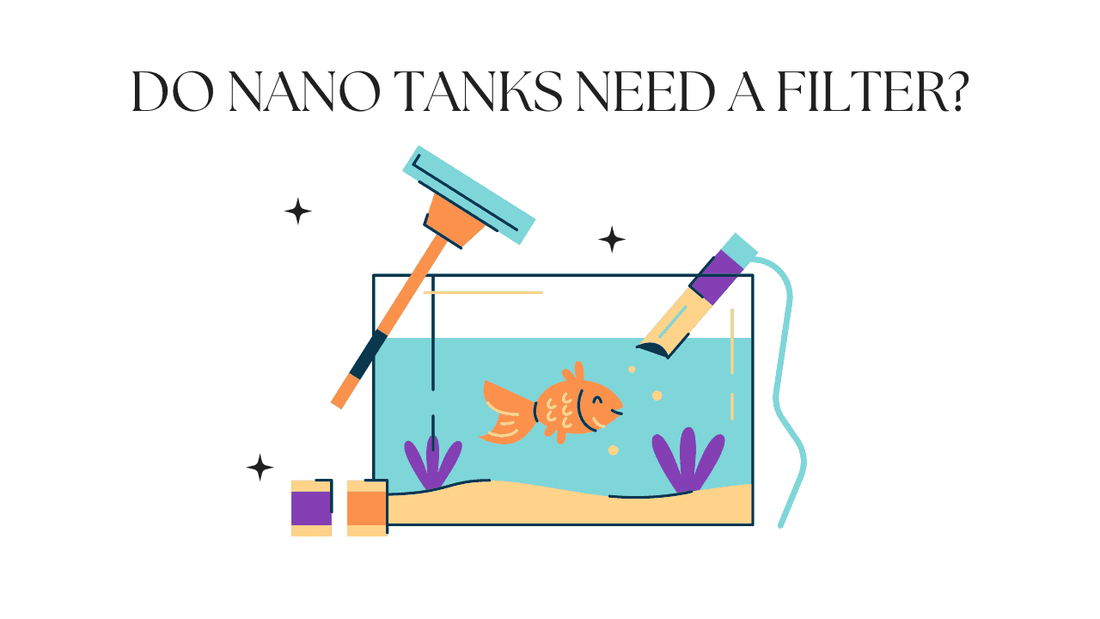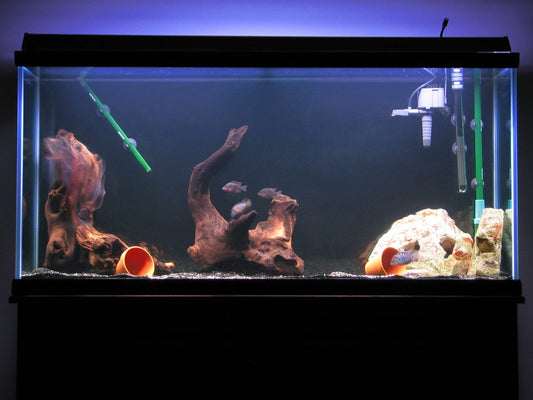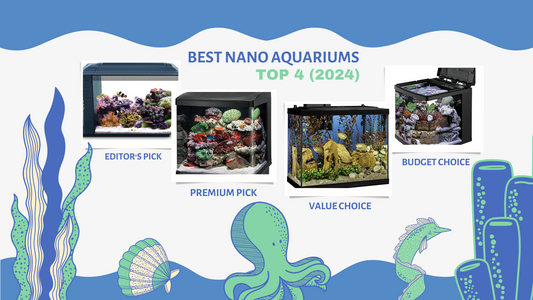Do Nano Tanks Need a Filter? (May 2024)

“Do nano tanks need a filter?” Picture the elegance of a nano tank, a piece of aquatic art perfectly suited for your chic living space or office. Yet, with its compact design, ensuring a harmonious, healthy habitat for your finned friends becomes as intricate as balancing a pencil on its tip.
Problem? – You’re introducing your friends or colleagues to your new nano tank. Everyone’s admiring its beauty until someone points out the water’s murkiness or, worse, a fish in distress. “Isn’t it supposed to be clear?” they ask, their eyebrows raised in genuine concern or, maybe, just a touch of judgment. Over time, uneaten food, fish waste, and organic matter can play havoc with the water quality. And trust me, murky water and distressed fish aren’t the relaxing, aesthetic pleasures you were aiming for.
Enter the saviors:
- Power Filter (with the rocking AquaClear 20 leading the charts)
- Sponge Filter (shoutout to Hygger Aquarium Double Sponge Filter)
- Canister Filter (SunSun HW-603B, you beauty)
- Internal Filter (Tetra Whisper Internal Filter doesn’t just whisper, it purifies)
They tackle the trifecta of filtration: Mechanical, Biological, and Chemical, ensuring your nano tank remains a crystal-clear paradise. With filters equipped for easy maintenance and whisper-quiet operation, your nano tank can remain the peaceful, vibrant oasis you envisioned.
Let’s keep that water pristine and those finned friends happy!

Understanding Nano Tanks
Nano aquariums, in the vast world of fish keeping, are the equivalent of chic studio apartments in bustling city centers. Compact, aesthetically pleasing, and perfect for individuals who appreciate the beauty of marine biology on a more miniature scale.
Most nano tanks are small aquariums, typically holding 30 gallons of water or less. Their small size makes them popular for hobbyists with limited space, but it also poses challenges when it comes to maintaining stable water parameters.
Top-Rated Filters for Nano Tanks in 2024
To help you narrow down your choices, we have compiled a list of The Top 4 Best Nano Aquarium Filters based on customer reviews, ratings, and expert opinions;
In a hurry? I recommend AquaClear 20
Types of Nano Aquarium Filters
Power Filter: AquaClear 20

The best power filter for nano tanks is the AquaClear 20. This filter has a unique design that allows you to customize the filter media according to your needs. It has a 100 GPH flow rate and a large media capacity that provides superior filtration.
It also has a patented re-filtration system that reduces the water flow without compromising the filtration efficiency. It is suitable for tanks up to 20 gallons.
Pros:
- Customizable Filter Media
- Patented Re-filtration System
- Large Media Capacity
Cons:
- For some users, the flow rate might be too strong for very small nano tanks.
- Some users may find it bulkier than other nano tank filter options.
Sponge Filter: Hygger Aquarium Double Sponge Filter

It also has an adjustable flow rate and a quiet air pump. It is suitable for tanks up to 20 gallons.
Pros:
- Dual Sponge Design
- Quiet Air Pump
- Adjustable Flow Rate
Cons:
- Sponge filters may not be as aesthetically pleasing in some tank setups.
- Over time, sponges will need replacement, which could mean additional maintenance.
You can find it on Amazon here: Hygger Aquarium Double Sponge Filter
Canister Filter: SunSun HW-603B

It is easy to set up and maintain, and it comes with all the necessary accessories. It is suitable for tanks up to 40 gallons.
Pros:
- Compact Design
- 3-Stage Filtration
- Easy Setup and Maintenance
Cons:
- Canister filters are typically more complex than simpler filters, which might be intimidating for beginners.
- Some users may experience leaking issues if not set up properly.
You can find it on Amazon here: SunSun HW-603B
Internal Filter: Tetra Whisper

It also has an air pump that provides oxygenation and water movement. It is suitable for tanks up to 10 gallons.
Pros:
- Discreet Design
- 3-Stage Filtration
- Air Pump Inclusion
Cons:
- The 45 GPH flow rate might not be sufficient for tanks closer to its maximum capacity.
- Some users might find it a bit louder than “whisper” quiet, especially if not installed correctly.

Filter Differences: The Fab Four
-
Power Filter (e.g., AquaClear 20):
- The “caffeine jolt” of filters. They hang on the back of the tank and use electricity to pull water through a filter media. Power filters are effective and versatile. And speaking of powerhouses, the AquaClear 20 is the front-runner. It’s like that pair of jeans that fits just right – reliable, efficient, and makes everything look better.
-
Sponge Filter (e.g., Hygger Aquarium Double Sponge Filter):
- Think of these as the yoga instructors of the filter world. Gentle, but effective. They use air pumps to draw water through a sponge, providing biological and mechanical filtration. They’re perfect for tanks with tiny critters who might get sucked into more powerful filters.
-
Canister Filter (e.g., SunSun HW-603B):
- This is the gourmet chef’s choice for aquarium filtration. They sit outside the tank and can handle all three types of filtration. They’re a bit more complex but oh boy, do they deliver.
-
Internal Filter (e.g., Tetra Whisper):
- They live inside the tank, are usually submersible, and are pretty quiet. The introverts of the filter world. They’re solid choices for smaller tanks where an external filter might be overkill.
Factors to Consider When Buying a Filter for a Nano Tank
Filter Type (Mechanical, Biological, Chemical)
Mechanical Filtration: This is the process where small particles, including fish waste and organic matter, are physically trapped. Sponge filters are a common choice for mechanical filtration in nano tanks, thanks to their ability to sift out debris without taking up much space inside the tank.
Biological Filtration: Fish waste, uneaten food, and other organic substances can decompose and harm your fish. Biological filtration breaks down these harmful substances, ensuring good aquarium water quality. Many canister filters and HOB filter (hang on back) filters are equipped with media that promote beneficial bacterial growth to handle this task. Yes, some bacteria are our friends!
Chemical Filtration: Using activated carbon or other media, chemical filtration removes unwanted chemicals from the water. Some of the best aquarium canister filters excel in this department. The goal is to keep the water parameters stable, ensuring zebra danios, nano reefs, and even that delicate live rock remain in tip-top shape.
Ease of Maintenance
The best filters are not just effective; they’re also easily accessible for cleaning and maintenance. You don’t want to dive deep into marine biology only to get stuck in the intricate maintenance of an external canister filter. For many fish enthusiasts, self-priming features and easy-to-change media make for a good aquarium filter.
Regular water changes are a given, but having a user-friendly filtration system will further improve water quality without making you pull your hair out.
Noise Levels
For those peaceful moments when you’re gazing at your small fish navigating their nano kingdom, the last thing you want is the relentless hum or buzz of a noisy filter. External filters, including most canister filters, are known for their quiet operation. HOB (hang on back) filters, which hang at the back of the tank, can also be discreet if you opt for a quality brand.
Remember, the serene ambience is part of the appeal of fish keeping.
The Importance in Nano Aquarium Filters
Given the limited volume of water in most nano aquariums, even small disturbances can lead to dramatic shifts in water quality. This makes choosing the best filter crucial. While larger tanks can sometimes dilute minor issues, small tanks are less forgiving. A sudden spike in fish waste or a dip in water quality can quickly become problematic in a small aquarium.
Filtration capacity, in this context, is paramount. Whether you’re using an external canister filter, a HOB (hang on back) filter, or another type, it should be able to handle the demands of your specific nano environment, from the swift zebra danios to the picturesque nano reef.
The spray bar in many canister filters helps distribute clean water evenly, avoiding “dead spots” in the tank. The best features of these filters are not just in their filtration capacity but also in their ability to promote a healthier environment for both small fish and other aquatic inhabitants.
Frequently Asked Questions About Nano Tank Filters
Do I need a filter for my aquarium?
Generally, yes. Think of it as having an air purifier in a room. You can survive without it, but the environment is healthier and cleaner with one.
Can Nano Tanks Function Without Filters?
Technically, yes, but it’s not advisable. Think of it like braving winter without a jacket. You might be okay for a bit, but why risk the discomfort and potential harm?
Do Planted Nano Tanks Require a Different Filter?
Plants do provide some natural filtration, acting as nature’s own filter. But relying solely on them would be akin to using a fan instead of an air conditioner on a sweltering summer day.
How do you ensure the optimal filtration for a nano tank?
Choose the right size filter for your tank’s volume and ensure it’s well-maintained. Just like finding that perfect pair of shoes: it needs to fit right and be kept clean.
What is the best power filter for a 15-gallon tank?
Cue the drumroll… The AquaClear 20 takes the trophy. Consider it the James Bond of filters – always on point and never missing its target.
How often should filter media in a nano tank be replaced?
Usually every 3-6 weeks, but it’s essential to heed the manufacturer’s guidance. Imagine it’s like refreshing your wardrobe essentials – but for fish.
How Often to Change Water with and without Filters
With a filter: every 2-4 weeks, depending on the tank’s conditions. Without one: considerably more often, making it seem like another part-time job, right?
Can you run a fish tank without a filter?
It’s possible, but not ideal. Just imagine fish picketing with tiny signs advocating for better living conditions. You wouldn’t want to be on the wrong side of fish rights!
We hope this clears up some of your burning questions about nano tank filters. If you’re just starting out or even if you’re an aquarium aficionado, we invite you to join our community. Dive into the Aquariums For Beginners Facebook group with over 460k+ enthusiastic members. Share, learn, and discuss all things aquatic.
For a deeper dive into the world of aquariums, don’t miss out on these insightful articles:

Conclusion
In the world of nano aquariums, where every drop of water counts, ensuring optimal filtration is paramount. Whether it’s mechanical filtration catching those small particles, biological processes balancing your water parameters, or chemical filtration clearing out unwanted compounds, the right filter makes all the difference.
Remember, while small in size, nano tanks hold a universe of wonder inside, and with the right care, they can be a mesmerizing window into the world of marine biology.
No comments






comments